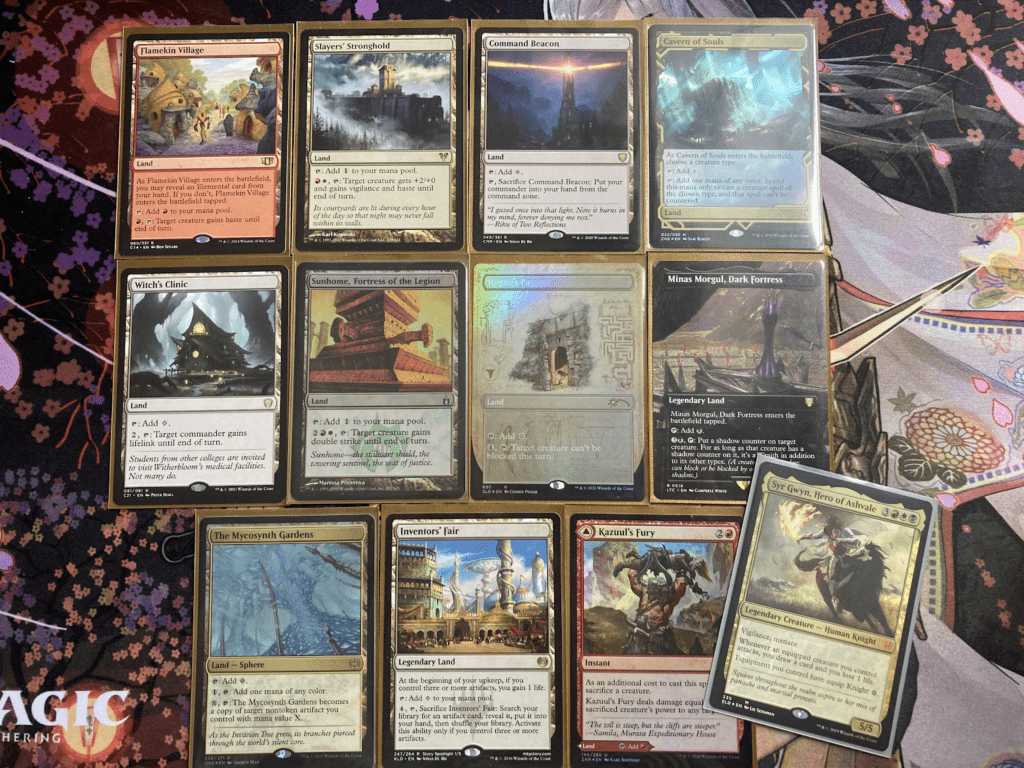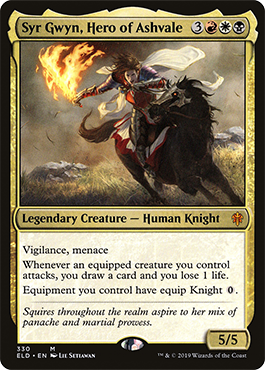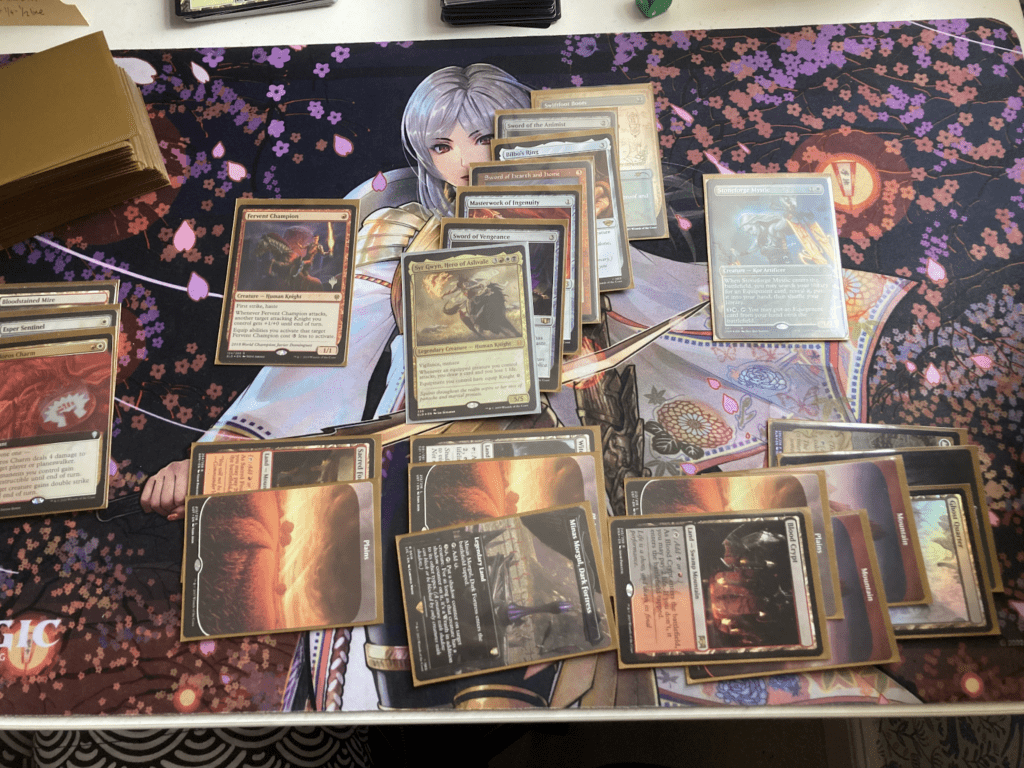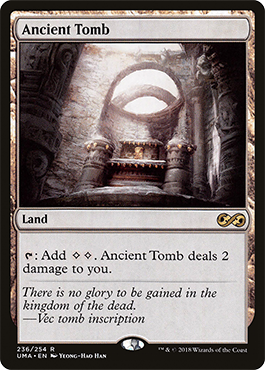When building a manabase, a lot of effort goes into making sure you can cast your spells by having the correct color sources. Identifying good utility lands to add is easy enough, especially if you checked out our list of 20 of the Best Utility Lands. But how do you wring out the last bit of value from the manabase?
UTILITY LANDS
As I covered last week, the format has some real haymaker utility lands to choose from. Whether you’re opting for Ancient Tomb and Gaea’s Cradle in high power decks, or Field of the Dead for the extra tokens, or a Maze of Ith because your playgroup favors chunky attackers, there’s something for every deck.
You can’t just take ten of those and call it a day, though, as you’ll be missing out on micro-synergies that can help elevate your deck’s potential. This week, let’s examine how to build a manabase that complements a Commander deck’s strategy.
SYR GWYN, HERO OF ASHVALE
I’ve been playing Syr Gwyn for *checks watch* …five years now? Time does indeed fly. Either way, it’s a deck I’m intimately familiar with, so let’s examine the utility lands in the mana base.

Picking utility lands for this deck involved identifying what my win conditions were, and then trying to patch up the weaknesses. In this instance, my win condition is Commander damage, with a secondary win condition of “a really big creature hitting hard” damage.
The weakness of the strategy include, but are not limited to:
- Syr Gwyn being removed
- Blockers
- Fogs
- Countering Syr Gwyn
- Not having enough damage on crucial turns to eliminate players
- Not untapping with enough boardstate to win
With that in mind, I set about choosing my utility lands. Connecting with Gwyn or indeed any voltron creature requires seizing opportunity, so Flamekin Village and Slayers’ Stronghold are both in the mix. While Hanweir Battlements is usually my first choice, here I valued the red source in a three-color deck, and the Vigilance and buff for my other smaller bodies.
Cavern of Souls on Knight means we won’t get blown out by Mana Drain with our juicy six mana Commander, and it helps us with fixing too. Command Beacon is similar – it helps get Gwyn into play through removal and wraths.
Keywords are excellent, and most of the best equipment have keywords on. Balancing where to get those keywords is hard though, especially when you also want to run equipment that help ramp, or draw cards. As such, putting Witch’s Clinic and Sunhome into the manabase give us extra shots at key effects.
Getting around blockers is usually fine with Menace and Protection, but eventually there’ll be too much to barrel through. Rogue’s Passage and Minas Morgul, Dark Fortress excel here, with the latter being a black source too.
Rounding things out, Inventors’ Fair puts a tutor into the manabase, freeing a deck slot up for another spell, while Mycosynth Gardens copies our best equipment to help skirt removal or build a taller voltron threat. Kazuul’s Fury is the secret sauce, and like all spicy sauces, is red, too. There will be times when you feel checkmated, unable to decide which deck to kill and which to hope doesn’t untap and win. Kazuul’s Fury, in theory, lets you do both, flinging your 20+ power creature after combat – or just in response to removal or a fog.
THOUGHT EXERCISE
Thought exercises are useful, even when you feel like you’ve got things polished. I sat down to write about this when I had a great game with the deck at the weekend.
Incidentally, I just got done writing about Boros Charm for last week’s article on Combat Tricks, and it showed up for me here to enable the one-hit Commander damage knockout, which is very satisfying indeed. But back to lands – winning that game came off the back of Minas Morgul’s shadow, Witch’s Clinic’s ability to put me back above 40 life and tank damage, and Sunhome’s doublestrike to Commander Damage the final opponent in one swing.
That said, I also realized something when putting this article together: I should probably be playing Mistveil Plains, as it’s a white source in a three color deck, and invaluable when combined with Sunforger. Syr Gwyn is a Sunforger deck, after all. It’s in there again now, and so even sitting down to think about the manabase from this angle, with a fresh perspective, has led to a nice little edit. Hurrah!
SPEAKING OF MISTVEIL PLAINS
While we’re on the topic of Mistveil Plains, I fished the copy out of my Hofri Reanimator deck when I looked at that deck for this article.

Hofri is a Reanimator build, showcasing the best of the Boros Advantage Engine. It’s also got a lands subtheme, as it wants to get them in the yard for Cavalier of Flame wins. As you can see with this manabase, it runs three fetchlands, Lotus Field, Ash Barrens, Myriad Landscape, Roadside Reliquary, Cryptic Caves and Sunbaked Canyon, all of which can put themselves into the yard, and all of which can be Brought Back (get it?) by Sun Titan, Redemption Choir, and other effects.
Because it’s primarily a reanimator deck, it runs Elegant Parlor and High Market to get creatures into the yard, and Emeria to bring them back. It runs the Song-Mad Treachery MDFC (that Threatens) because of how Hofri’s trigger works, netting us a token of that stolen creature if we can sacrifice it. It also now has a Geier Reach Sanitarium, which replaces the War Room I was running when I pulled up the list to talk about it. Again, it’s really useful to do this thought exercise from time to time. What lands am I running? Do they best serve my gameplan and win conditions? If not, should they be swapped?
It’s why I took Mistveil Plains out; it’s a tapped land in a higher power deck that already has plenty of tapped lands, and replacing it with another Plains keeps Plains count for Emeria and Emeria Shepherd, while increasing Basic count for Land Tax.
You’ll notice that the manabase for Hofri has less “contingency” than the one for Syr Gwyn. This is because the deck has more win conditions, and these win conditions don’t revolve around combat. The deck’s toolbox is firmly in the creatures it runs. It can make enough mana to “try again”, and can leverage cards like Dockside Extortionist for big turns. Check out the full decklist here.
HOW MANY UTILITY LANDS CAN I RUN?
Despite advice from Frank Karsten himself, most Commander players still run less than the suggested quantity of lands. I don’t think I know anyone that runs 40 lands outside of a landfall/green deck, and though I’m not going to suggest running 40 lands for the average deck, I do want to discuss for a moment my experience in running utility lands and deciding on land counts.
Generally speaking, my starting point is still 36 lands. If the deck is two-color, and trends to a low curve, I sometimes drop to 34-35. This is possible in Commander nowadays only because of the sheer quantity of card draw you can fit into decks. When I’m playing three colors or a higher curve, 36 is the minimum, and depending on how much treasure I make, consider going up to 38.
Now, while running more lands can sometimes leave you feeling like you’re flooding, it can also give you more room for utility lands. Because I favor running at least 10 basics in a three-color deck, and at least 13-16 in a two-color deck, the actual space for utility lands is hotly contested – as it should be. Running a high quantity of basics ensures you aren’t stuck behind tapped lands, it enables you to capitalize on certain forms of ramp, it helps you use The Initiative, even if you take it from someone else, and on the off chance you run into non-basic land hate, you aren’t dead in the water.
While utility lands are great, it’s hard to justify running more than a couple that don’t tap for mana (like Maze of Ith, or Cabal Coffers) and more than 10 that don’t tap for one or more of your colors in a two-color deck. When I’m in three colors, I try to stick to fewer than that, and settle usually around 5.

Isshin Dungeons, for example, runs Access Tunnel to enable small attackers, Scavenger Grounds to remove graveyards, Temple of the False God to help recasting Isshin, and Slayers’ Stronghold and Hanweir Battlements to help haste out key attackers. Other than that, both Bojuka Bog and Flamekin Village are colored sources in a 3-color deck that give redundancy to the other utility lands, and the rest is color-fixing. Isshin skirts low at 34 lands, but makes oodles of treasure by attacking, so can get away with a slightly lower land count. That said, the lower land count also stops me running more than a handful of utility lands.
It would be easy to go the other way and introduce more utility lands, but that would be greedy in this instance, and result in way more games where I struggle to cast my spells. Remember that Isshin is one of each color, and getting him out reliably on-curve is way more important than running whatever other utility land in place of color-fixing.
END STEP
It’s easy to throw together a rudimentary manabase for a new deck, and honestly? You’ll probably still get a lot of mileage out of it, because the advent of Treasure and the high-variance of Commander in general means you’re less likely to notice where your manabase is hampering your deck’s power and consistency. If you want to take your deck up a notch and get those last few % points of power out of it, or you notice yourself unable to cast the spells you want to cast on curve, in the right order, it might be time to take an objective look at where your manabase might be letting you down, and where there is opportunity.
Take a card like Ancient Tomb. If you’re not winning super quickly, or if you don’t have lifegain in your deck, this card might actually be detrimental to your win rate. This is even more relevant when you have a Commander like Isshin; there’s a reason I don’t run it in Isshin, and it’s because it doesn’t really help me cast a lot of the early game creatures, or Isshin himself. I do run Temple of the False God, though, because I’m never keeping a hand with it, and when it does come down later, it can help to get some high-curve finishers out, or recast Isshin.
There’s an argument I should run it in Syr Gwyn, but as I discussed in “Is Smothering Tithe a Fair Card”, my consideration for not running it is the same as why I don’t currently run Teferi’s Protection; “Smushing Consistency”. I want the deck to have a consistent experience across the table, and I want to create puzzles that are solvable, because that’s the power level I’ve intended for the deck. I don’t want people to play against the deck with Ancient Tomb and decide it’s faster than its average draw.
I hope this article has prompted some useful approaches to take into deckbuilding, and for next time you tweak one of your builds.

Kristen is Card Kingdom’s Head Writer and a member of the Commander Format Panel. Formerly a competitive Pokémon TCG grinder, she has been playing Magic since Shadows Over Innistrad, which in her opinion, was a great set to start with. When she’s not taking names with Equipment and Aggro strategies in Commander, she loves to play any form of Limited.




